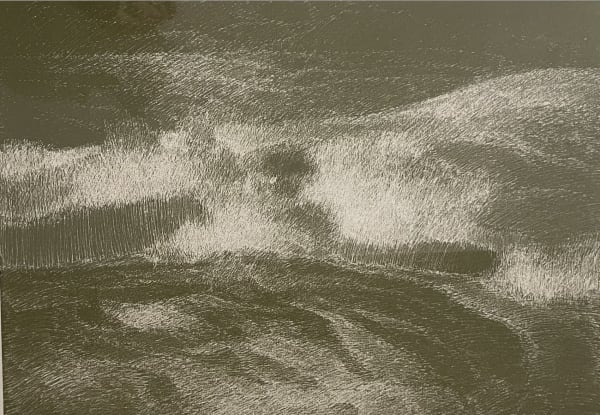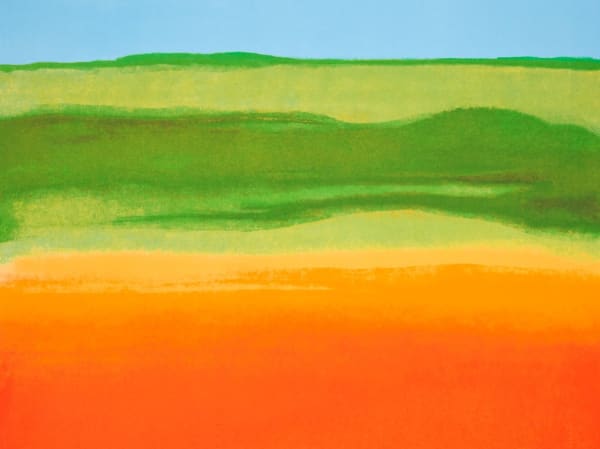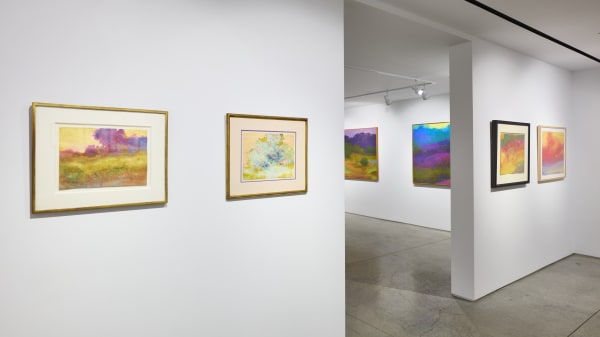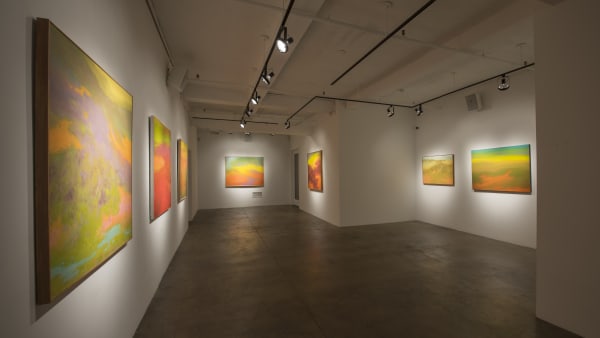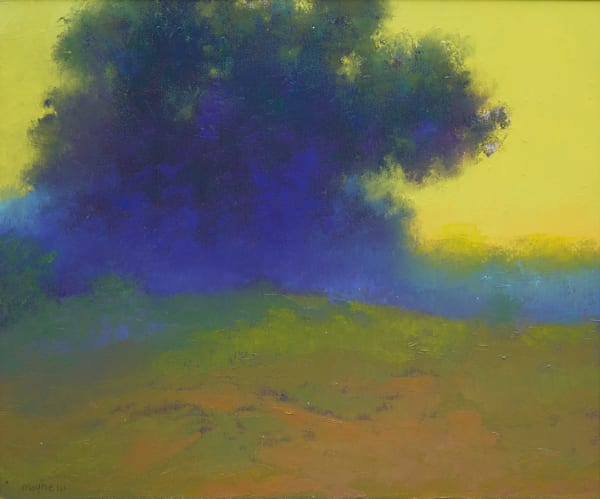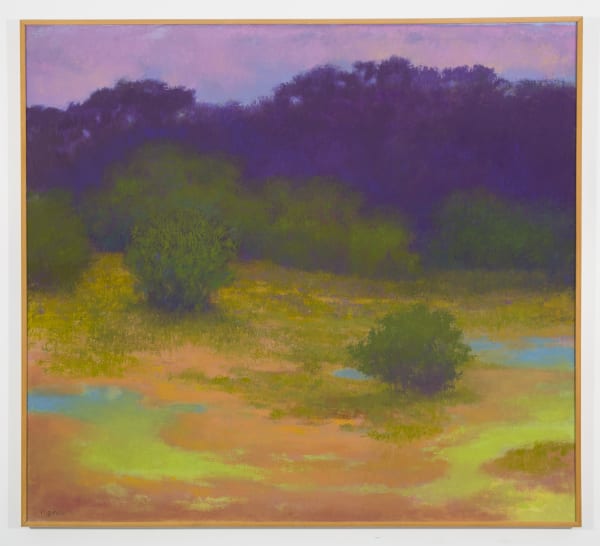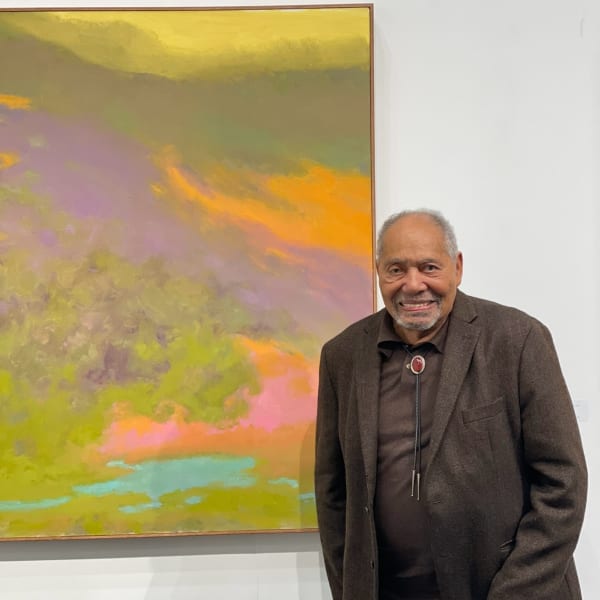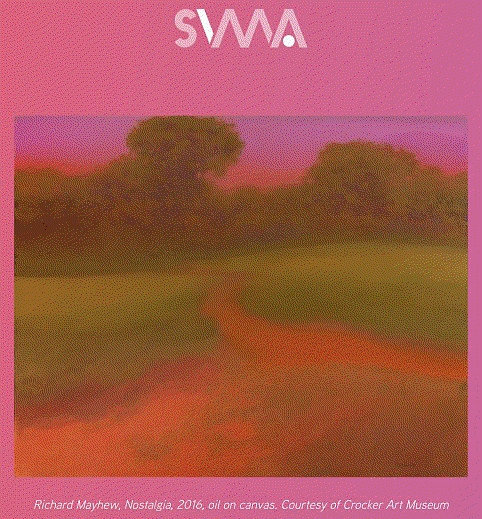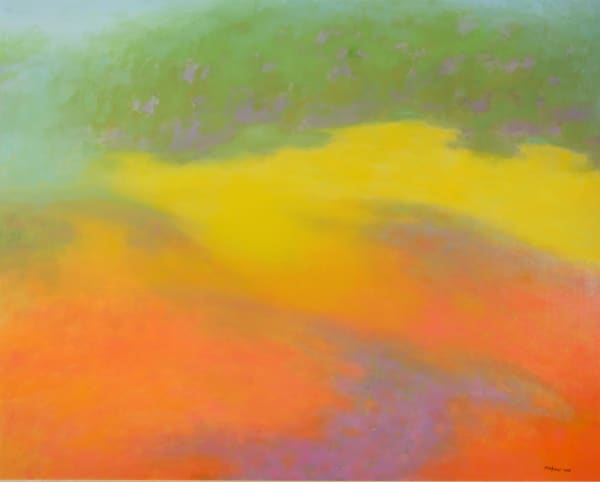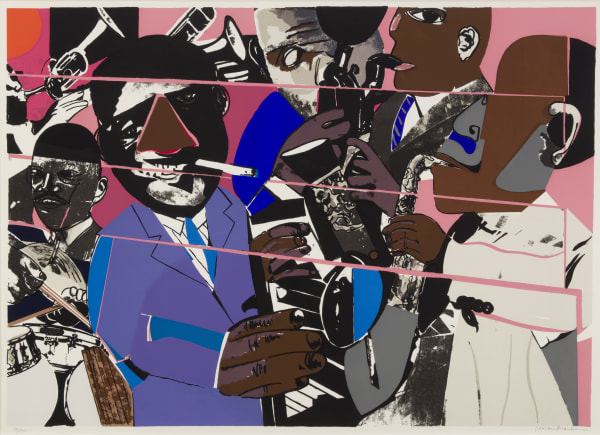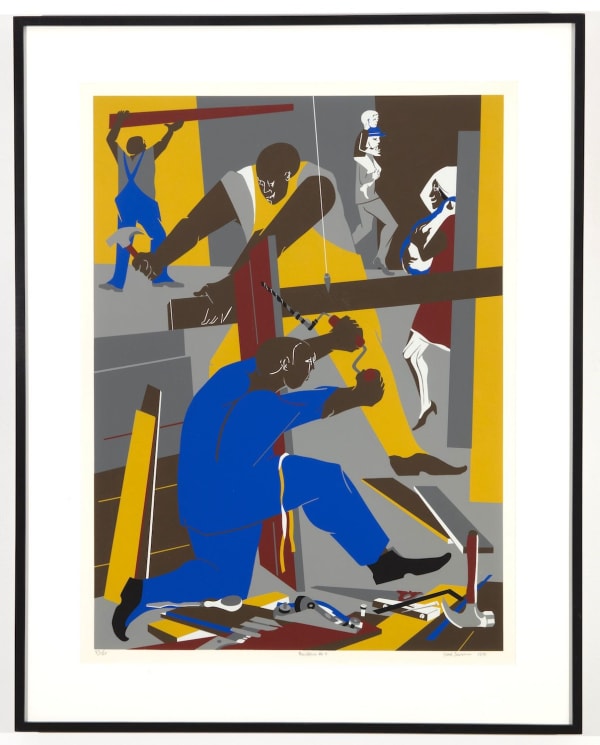Richard Mayhew 1924-2024
For Richard Mayhew, the essence of reality is more important than its facts. His landscape paintings aren’t the facts of a landscape but the spirit of a landscape. That spirit shimmers through a haze saturated with color.
His emotional and spiritual connection to the natural world has its roots in his African American and Native American ancestry: his father was African American and Shinnecock; his mother, African American and Cherokee. During his boyhood, his paternal grandmother supported his art endeavors and schooled him in the Native Americans kinship with the earth.
After his service as a Montfort Point Marine, Mayhew moved to New York in 1947, a crucial period in American art history. Abstract Expressionism, the first truly homegrown American art movement, was electrifying the public, igniting passionate discussions among the cognoscenti about what constitutes art in the first place and what is its purpose in the public realm. Richard Mayhew, now a student at the Brooklyn Museum’s school of art, with additional courses at Pratt Institute and Columbia, thrived in this fevered environment. The painterly freedom of the Abstract Expressionists had a profound influence on Richard Mayhew, opening his canvases to the wild essence of being that was in kinship with the spirituality of his heritage.
Critical notice came quickly. Mayhew had his first solo show in 1955 at the Brooklyn Museum. In 1959, he won the John Hay Whitney Fellowship, which funded a year of studies at the Accademia delle Belle Arti in Florence, during which his wife and two children accompanied him. A subsequent grant from the Ford Foundation allowed him to remain in Europe after his training. His exposure to the rich history of European art further expanded his vision. He was particularly excited by the French Impressionists, whose experiments with light and color would inform Richard Mayhew’s landscapes. In 1969/70 Mayhew was inducted into the National Academy of Art.
When Mayhew returned to New York in 1962, the city and much of America was in the throes of the Civil Rights Movement. Many artists, especially African American artists, involved themselves in the struggle. In 1963, he joined Spiral, a group formed by Romare Bearden, Charles Alston, Norman Lewis, Felrath Hines and Hale Woodruff, to discuss the role of African American artists in the political and cultural landscape of America. Though Richard Mayhew was an active participant in Spiral and the Civil Rights struggle, his art, unlike that of his Spiral colleagues, was not grounded in African American themes. He remained true to his pursuit of transcendence through the spirituality of the landscapes he portrayed.
Richard Mayhew is equally respected as an educator. He has taught at the Brooklyn Museum, the Art Students League, Smith College, and Pennsylvania State University, where he retired as Professor Emeritus in 1991 after 14 years at the school. During his Penn State years, Mayhew travelled across America. He was deeply affected by the color, shapes, drama and spirituality of the American west. Upon his retirement from teaching, Richard Mayhew and his wife moved to Santa Cruz, California, where he continues to paint.
In addition to the Whitney and Ford grants, Richard Mayhew has been the recipient of several honors and awards including the Ingram Merrill Foundation Award, Tiffany Foundation Award, a National Institutes of Arts and Letters grant, the Childe Hassam Purchase Award, the National Academy of Design Merit Award and the Grumbacher Gold Medal. His work is represented in major collections including the Whitney Museum of American Art, the Brooklyn Museum, the Los Angeles County Museum, and the National Gallery of Art in Washington, D.C., among others.
In September of 2024, Richard Mayhew passed away peacefully at age 100.
References: The Art of Richard Mayhew. Museum of the Diaspora, San Francisco, CA, 2009.
-

Richard Mayhew: A Life in Art
Jan 21 - Feb 15, 2025ACA Galleries is delighted to present a solo exhibition of Richard Mayhew’s transcendent landscapes. Richard Mayhew: A Life in Art will provide a retrospective-style survey of his signature oil paintings and watercolors, in celebration of the life and work of the artist, who recently passed away at the age of 100.Read more -

Beyond the Spiral
Amos, Bearden, Lewis, Mayhew, and others Oct 28, 2023 - Jan 20, 2024This exhibition presents the artists from the legendary Spiral Group and the ways their artwork and production were influenced by their brief association. The Spiral Group was a New York–based African American artists’ collective active from 1963 to 1965. Founded by Charles Alston, Romare Bearden, Norman Lewis, and Hale Woodruff to explore the relationships between art and activism. The group also included artists Emma Amos, Calvin Douglass, Perry Ferguson, Reginald Gammon, Felrath Hines, Alvin Hollingsworth, William Majors, Richard Mayhew, Earl Miller, Merton D. Simpson and James Yeargans.Read more
-

A Black Perspective
Jan 8 - Jul 30, 2021Read more -

Richard Mayhew
Transcendence Jun 4 - Nov 14, 2020Read more -

On Such a Night as This: A Celebration of African American Art
Nov 10, 2016 - Jan 28, 2017Read more -

Herb Alpert & Richard Mayhew
Harmonic Rhythms Feb 19 - Apr 18, 2015Read more
-

A Tribute to Three Masters
Robert Carter, Charles White and Richard Mayhew Apr 3, 2025Please join us Thursday, April 3 from 5 – 8pm. Robert Carter, Karli Wurzelbacher and Mikaela Sardo Lamarche in conversation. The conversation will begin at...Read more -

On View: Posthumous Survey of Luminous Landscapes by Richard Mayhew
Victoria Valentine, Culture Type Feb 11, 2025The Luminous Landscapes of Richard Mayhew (1924-2024) evoke a sense of spiritual transcendence. Mayhew pictured abstracted and imagined places that evince expansive meadows and watercolor...Read more -

Richard Mayhew, Painter of Abstract Landscapes, Dies at 100
Alex Williams, New York Times Oct 5, 2024Richard Mayhew, a painter of Black and Native American heritage who was known for his explosively colorful abstract landscapes — he called them “mindscapes” —...Read more -

Richard Mayhew, Abstract Artist Who Painted Hazy Visions of the World Around Us, Dies at 100
Maximilíano Durón, ARTnews Sep 27, 2024Richard Mayhew , who was known for his hazy abstract paintings that at times resembled landscapes, died on Thursday at the age of 100. The...Read more -

With great sadness we announce the passing of Richard Mayhew who captured the spiritual essence of landscapes
Sep 27, 2024'Richard Mayhew’s legacy lies not only in his mastery of color and landscape but in his ability to transcend the physical world, evoking emotion and...Read more -

Richard Mayhew exhibit opens at Sonoma Valley Museum of Art
A talk with the 99-year-old artist is planned for Sunday and open to the public. Sep 23, 2023written by editor at the Press Democrat. Richard Mayhew came to the Sonoma Valley Museum of Art on Saturday for the opening of “Richard Mayhew:...Read more -

Richard Mayhew: Inner Terrain
Sonoma Valley Museum of Art May 4, 2023A rare and timely exhibition of the artwork of Richard Mayhew (b. 1924), featuring two dozen paintings that speak to American arts, culture, and history. Mayhew’s African American, Shinnecock, and Cherokee-Lumbee ancestries inform his dreamlike landscapes, which are saturated in vibrant colors, including shades of red and burnt earth pigments that suggest, as the artist has said, “blood in the soil.”Read more -

‘Black Art: In the Absence of Light’ Reveals a History of Neglect and Triumph
The New York Times, Holland Cotter Feb 8, 2021“This is Black art. And it matters. And it’s been going on for two hundred years. Deal with it.” So declares the art historian Maurice Berger toward the beginning of “Black Art: In the Absence of Light,” a rich and absorbing documentary directed by Sam Pollard (“MLK/FBI”) and debuting on HBO Tuesday night. The feature-length film, assembled from interviews with contemporary artists, curators and scholars, was inspired by a single 1976 exhibition, “Two Centuries of Black American Art,” the first large-scale survey of African-American artists.Read more -

Richard Mayhew: Transcendence
Exhibition Press Release Feb 5, 2020Exhibition: MARCH 26 TO MAY 9, 2020 ACA Galleries is pleased to present a solo exhibition of Richard Mayhew, Transcendence , which celebrates the release...Read more -

Art Review: Tuning in to African American Art
Herald-Tribune, Marty Fugate Jan 19, 2020‘Spectrum: A Celebration of Artistic Diversity’: Runs through Feb. 6 at Ringling College’s Lois & David Stulberg Gallery, 1188 Dr. Martin Luther King Way, Sarasota....Read more
-

Art Basel Miami Beach
Richard Mayhew Dec 5 - 7, 2025For over 7 decades Richard Mayhew pursued a singular subject, the landscape. His steadfast commitment and innovation to the genre is unparalleled in contemporary art....Read more -

The American Art Fair
Selections from the Gallery's collection of American Art May 10 - 13, 2025ACA Galleries is pleased to present a selection of historical works from the gallery’s collection of American Art including Edward Bannister, Romare Bearden, Robert Duncanson, Jacob Lawrence, Richard Mayhew and Henry O. Tanner, among others.Read more -
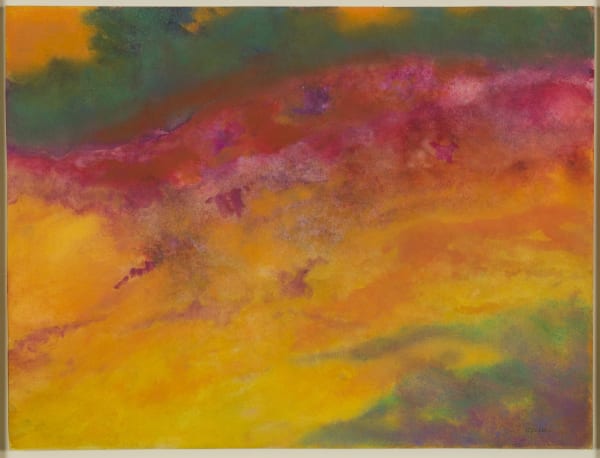
The Art Show
Richard Mayhew: Mindscapes booth C13 Nov 1 - 4, 2023This solo presentation celebrates the iconic mindscape paintings of Richard Mayhew, (b. 1924). Landscape is often overlooked as a contemporary subject, and over seven decades...Read more




